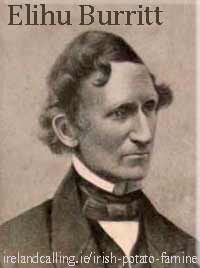The Irish Famine of the late 1840s led to some impressive and often moving acts of generosity from people across the world, many of who had no connection with Ireland.
Donations came from people in all walks of life including the Irish themselves, the Pope, the British Royal family, a Native American tribe, the Sultan of Turkey, Protestant churches, magazine journalists, prison convicts…and many thousands more.

The British government has been widely and justly criticised for its callous attitude towards famine victims, which led to thousands of unnecessary deaths. However, the indifference of government ministers is in sharp contrast to the generosity of the ordinary people of Britain who supported numerous famine appeals, particularly in the first few years.
The Quakers were especially active, raising hundreds of thousands of euros in today’s money for famine relief.
Irish soldiers serving with the British army in Calcutta, and employees of the East India Company, many of them Irish, raised more than £14,000, which would be worth more than a million euros today.
The Heritage Centre at Skibbereen in Co Cork, one of the worst affected areas during the famine, has compiled this list giving a fascinating cross section of contributors. Most of the figures are given in British pounds, the currency in use in Ireland at the time of the famine.
The value of the donations today is given in euros
Donor |
Donation |
Value today |
| Queen Victoria | £2,500 | €207,000 |
| Queen Victoria’s servants | £247 | €20,500 |
| RC Diocese of Strasbourg | 23,365 marks . . | €82,700 |
| Sultan of Turkey | £1,000 | €82,700 |
| Royal Irish Art Union | £200 | €16,500 |
| Irish Coast Guard | £429 | €35,500 |
| Dowlas Iron Works employees | £171 | €14,200 |
| Punch magazine journalists | £50 | €4,100 |
| Regent’s Park Barracks, London | £3,000 | €248,000 |
| Anglian Church Amsterdam | £561 | €46,400 |
| Baptist Chapel, Cambridge | £500 | €41,300 |
| Vicar Apostolic, Mauritius | £2,211 | €182,800 |
| Indian Relief Fund | £14,000 | €1,158,000 |
| New Brunswick Subscriptions | £1,640 | €135,600 |
| British Residents in Mexico | £652 | €53,900 |
| St Petersburg Subscriptions | £2,644 | €218,600 |
| Malta and Gozo | £720 | €59,500 |
| Convicts on Prison Ship, Warrior Woolwich . | 17 shillings | €70 |
| Choctaw Nation | $170 | €68,500 |
| Barbados | £2,000 | €165,400 |
Publicity of terrible conditions boosted fundraising
 Publicity about the terrible conditions the destitute had to endure helped to increase donations. The reporter and artist James Mahony produced several reports and sketches on the famine for the Illustrated London News. This boosted fundraising for a few months towards the beginning of 1847.
Publicity about the terrible conditions the destitute had to endure helped to increase donations. The reporter and artist James Mahony produced several reports and sketches on the famine for the Illustrated London News. This boosted fundraising for a few months towards the beginning of 1847.
Two students from Oxford University, Lord Dufferin and G S Boyle, went to Ireland specifically to see the devastation for themselves. They published a report on their visit called, Narrative of a Journey from Oxford to Skibbereen during the Year of the Irish Famine.
They gave the proceeds to the relief effort and Dufferin also made a separate, individual donation of a thousand pounds, which would be €82,700 in today’s money.
The American social reformer Elihu Burritt visited Skibbereen, one of the areas worst affected during the famine. He published an account of his visit called, A Journal of a Visit of Three Days to Skibbereen and its Neighbourhood. This raised awareness in America and elsewhere.
Most of the money donated came in the first two years of the famine between 1845 and 1847. After that, generosity was dampened as famine fatigue set in due to repeated appeals and collections.
Impoverished immigrants alarmed local populations
 Britain was also hit by an economic recession in 1847 which caused widespread unemployment as many businesses were forced to close, especially in the north of England.
Britain was also hit by an economic recession in 1847 which caused widespread unemployment as many businesses were forced to close, especially in the north of England.
This diverted attention away from Ireland as the English focused on providing relief to the needy in their own country.
From 1847 onwards, mass emigration from Ireland led to a large influx of famine victims arriving in Britain and America. The huge numbers of largely impoverished immigrants alarmed the local populations.
In some cases, the sympathy that had led people to help the famine victims turned to resentment and contempt; the donations began to dry up.
It is impossible to say how many lives were saved as a result of charitable donations, but given the huge sums involved, it’s likely to be several tens of thousands.
famine.html